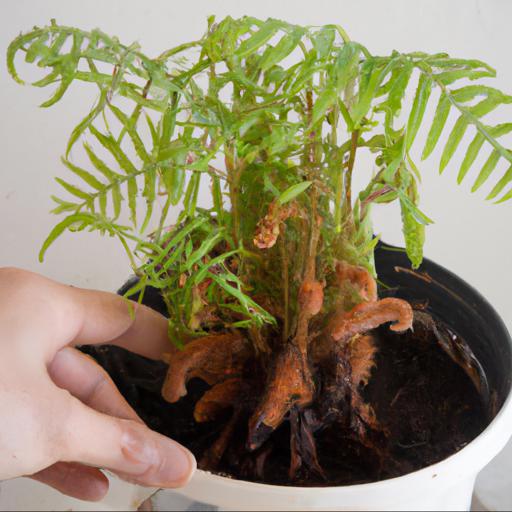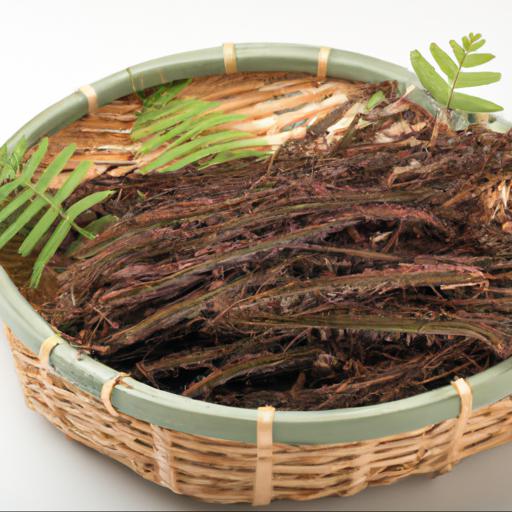Osmunda cinnamomea, commonly known as cinnamon fern, is a species of fern native to moist woodlands in North America. It is an evergreen perennial plant that grows in clusters and can reach heights of up to 4 feet. Its fronds are lacy and light green in color, and the fertile fronds are covered with a cinnamon-colored coating.
Osmunda cinnamomea is an important part of the native ecosystem, providing food and shelter for a variety of wildlife species. It is also a popular ornamental plant, valued for its attractive foliage and ease of care.
This hardy fern is easy to grow and can be a great addition to any garden.
Benefits of osmunda cinnamomea

Gardening experts will attest: adding osmunda cinnamomea to your garden can bring with it a wealth of benefits. This fern, found in parts of North America and Europe, is treasured for its bright green fronds and ease of care.
Apart from its unique form and color, the most striking thing about osmunda cinnamomea is its tolerance for both sun and shade. This makes it an ideal choice for areas of the garden that get both full sun and partial shade – a rare combination for many plants. Shade-tolerant plants like these are a boon for gardeners who struggle to find robust plants that thrive in the more shaded areas of their garden.
Additionally, given that it is a rather low-maintenance plant, it’s the perfect choice for beginner gardeners who are looking to really ramp up their home gardening. As far as its care needs, osmunda cinnamomea requires minimal soil fertilization and only occasional watering, making it a great choice for those not looking to break the bank on garden maintenance. This fern can tolerate a variety of soil pH levels, making it surprisingly versatile in terms of what conditions it can grow in.
Additionally, it’s unsurprisingly resistant to most types of bugs or disease, further removing any need for chemical treatments. If you’re looking for an attractive, hardy addition to your garden, you should seriously consider osmunda cinnamomea.
Its flashy color and hardiness make it a great choice for beginners, and its lack of need for heavy care can help ensure any garden will remain in pristine condition for years to come.
How to grow osmunda cinnamomea

Osmunda cinnamomea, more commonly known as cinnamon fern, is a majestic plant with attractive fronds and a graceful, arching form. As an evergreen perennial, it is one of the few ferns that can stay green and thrive in all four seasons. For gardeners lucky enough to have access to these majestic plants, there are a few tips to ensure they grow strong and healthy.
First, cinnamon ferns should be planted in moist, well-drained soil and given an area with plenty of shade. They grow best in clumps and can tolerate just about any soil type but will not do well in hot, dry conditions.
The plants should be kept humid and watered frequently to keep the fronds a vibrant green. For optimal growth, adding organic matter such as peat moss, compost, or manure to the soil is recommended.
Once your cinnamon ferns have been planted, you want to make sure to provide them with plenty of nutrients for optimal growth and health. A low-nitrogen, high-quality all-purpose fertilizer can be given during periods of active growth for maximum benefit. Be sure to avoid overfertilizing as this can cause the fronds to turn yellow and become sparse.
In summary, cinnamon ferns are an elegant and low-maintenance plant that can be grown in just about any soil type as long as it is kept moist and provided with plenty of shade. A low-nitrogen, high-quality all-purpose fertilizer should be used when they are actively growing to provide the plants with essential nutrients. With proper care and maintenance, your osmunda cinnamomea plants will provide your garden with a vibrant and lush addition all year round.
Common uses of osmunda cinnamomea

Osmunda cinnamomea, more popularly known as cinnamon fern, is widely recognized as a key component in gardens throughout the UK. This eye-catching variety of fern is mostly found near streams, rivers, or ponds and comes in two distinct varieties: interrupted and common cinnamon fern.
Not only is cinnamon fern considered an attractive addition to any outdoor space, but it is also incredibly useful. Its rhizomes offer stability wherever you might choose to plant your cinnamon fern, allowing it to thrive in a variety of locations whether in a container, in the ground, or even on a slope. Additionally, the rhizomes help to keep the soil moist and cool, which is crucial during the summer months.
This feature also makes it an excellent choice as a ground cover around ponds and streams, as it works to slow the flow of water, helping to reduce erosion and runoff. The fronds of the cinnamon fern are also packed with a variety of uses.
The feathery, matted layers of foliage make excellent mulch that can be used for top-dressing beds, borders, and containers. It is also known for its ability to retain moisture, helping to reduce water loss when placed over soil. Finally, the bright, light foliage of the cinnamon fern works as a perfect complementary backdrop for more colorful flowers, adding interesting texture and an undeniable character.
In summary, Osmunda cinnamomea, or cinnamon fern, is a useful and attractive addition to any UK garden. Its rhizomes help to stabilize the soil, while its fronds can be used as excellent mulch.
Finally, the feathery foliage provides a unique texture and visually appealing backdrop to any flower or shrubbery. For these reasons, it is easy to see why the cinnamon fern is a popular choice amongst gardeners.
Interesting facts about osmunda cinnamomea
Discovering new facts about the Osmunda cinnamomea, or cinnamon fern is an exciting task. As a UK gardening expert, I feel honoured to share some of my most interesting findings about this fascinating species. Native to many parts of North America, Osmunda cinnamomea is considered to be one of the oldest and most primitive of all ferns.
The leaves of this fern have a rough texture and a unique, curling appearance that sets them apart from other species. In spring, the leaves unfurl, turning a deep and glorious cinnamon-red colour before reverting to their pale green colour in autumn.
This vibrant colour provides a spectacular backdrop against the lush, green foliage of the garden. Another fascinating feature of the Osmunda cinnamomea is its reproductive behaviour.
This species engages in an unusual form of underground propagation known as ‘sporesphor’. Unlike other species of fern, Osmunda cinnamomea does not propagate via spores, but rather, using a combination of roots and underground stems. These stems produce underground buds which develop into mature plants.
This peculiar reproductive method has earned the cinnamon fern the nickname ‘The Rooted Fern’. Osmunda cinnamomea is also an incredibly hardy fern, capable of thriving in a variety of conditions.
This species will happily grow in both sunny and shady spots, although it prefers moderately moist, organic-rich soil. This fern can handle temperatures as low as -15 °C and is tolerant of salt and humidity, making it a great choice for coastal gardens. Overall, the Osmunda cinnamomea is an absolutely fantastic addition to any garden.
Its vibrant colour, resilience, and unusual reproductive methods make it a truly fascinating species. As a UK gardening expert, I highly recommend this fascinating fern as an essential feature in any garden.
Our video recommendation
Bottom Line
Osmunda cinnamomea, also known as cinnamon fern, is a species of fern native to North America. It is an integral part of the wetland ecosystem, providing habitat and food for a variety of wildlife. The fronds are light green and can reach up to 5 feet in length.
The cinnamon fern is a popular choice for landscaping due to its attractive foliage and its ability to thrive in a variety of environments. It is a hardy plant that is easy to care for, making it a great addition to any garden.
FAQ
What is the scientific name of Osmunda cinnamomea?
The scientific name of Osmunda cinnamomea is Osmunda cinnamomea.
What type of environment does Osmunda cinnamomea prefer?
Osmunda cinnamomea prefers a moist, acidic environment with plenty of organic matter.
What are the benefits of growing Osmunda cinnamomea?
The benefits of growing Osmunda cinnamomea include providing shelter and food for wildlife, improving soil quality, and adding aesthetic value to landscapes. Additionally, the plant is known to have medicinal properties and can be used to treat respiratory issues.
How often should Osmunda cinnamomea be watered?
Osmunda cinnamomea should be watered regularly, but not too often. It should be watered when the top inch of soil feels dry.
What type of soil is best for Osmunda cinnamomea?
The best type of soil for Osmunda cinnamomea is a moist, well-drained, acidic soil with a pH of 5.5 to 6.5.
How long does it take for Osmunda cinnamomea to reach maturity?
Osmunda cinnamomea typically takes between 3 and 5 years to reach maturity.

